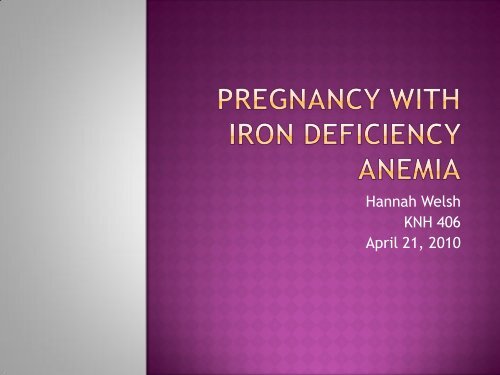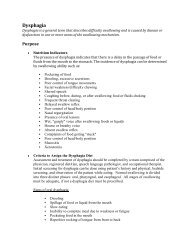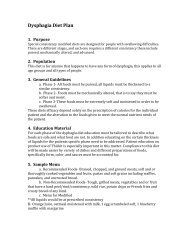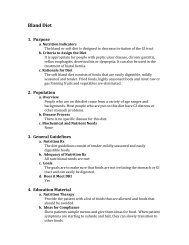Pregnancy with Iron Deficiency Anemia - Medical Nutrition Therapy ...
Pregnancy with Iron Deficiency Anemia - Medical Nutrition Therapy ...
Pregnancy with Iron Deficiency Anemia - Medical Nutrition Therapy ...
Create successful ePaper yourself
Turn your PDF publications into a flip-book with our unique Google optimized e-Paper software.
Hannah Welsh<br />
KNH 406<br />
April 21, 2010
Mrs. Sarah Henley<br />
Age: 31<br />
Wt. 135 pre, 145 currently<br />
Ht. 5’5<br />
Smoker<br />
23 rd week of Gestation<br />
Stay-at-Home mother, two son 12 months and 3<br />
years<br />
Chief Complaint: “ I went out to get the mail<br />
and slipped on the ice. After I got back I noticed<br />
a small amount of bleeding when I went to the<br />
bathroom. Over the next hour, I had some<br />
abdominal pain. I was afraid something might<br />
have happened to the baby”
Mrs. Henely is “gravida 3/para 2<br />
• Gravida-indicates the total number of times a woman<br />
has been pregnant, regardless of whether these<br />
pregnancies were carried to term. A current<br />
pregnancy, if any, is included in this count.<br />
• Para-indicates the number of viable (>20 wks) births.<br />
Pregnancies consisting of multiples, such as twins or<br />
triplets, count as ONE birth for the purpose of this<br />
notation.<br />
• Abortus- is the number of pregnancies that were lost<br />
for any reason, including induced abortions or<br />
miscarriages. The abortus term is sometimes dropped<br />
when no pregnancies have been lost.
PMH: Two previous pregnancies delivered at<br />
38 and 37 weeks respectively.<br />
Fatigue<br />
Short of breath<br />
Pale<br />
Prenatal vitamins<br />
Family history of CAD
Microcytic, Hypochromic <strong>Anemia</strong><br />
• <strong>Anemia</strong> is classified by the size of red blood cells<br />
• The size is reflected in the mean corpuscular<br />
volume (MCV).<br />
• If the cells are smaller than normal (under 80 fl),<br />
the anemia is said to be microcytic<br />
• If they are normal size (80–100 fl), normocytic;<br />
• If they are larger than normal (over 100 fl), the<br />
anemia is classified as macrocytic.
• Megablasic <strong>Anemia</strong>-is a blood disorder in which there is<br />
aneima <strong>with</strong> larger-than-normal red blood cells.<br />
• Pernicious <strong>Anemia</strong>-a decrease in red blood cells that<br />
occurs when the body cannot properly absorb vitamin<br />
B12 from the gastrointestinal tract.<br />
• Normocytic anemia- a blood disorder characterized by<br />
red blood cells which are of a normal size but present in<br />
insufficient quantities. It is often associated <strong>with</strong> chronic<br />
diseases, blood loss, bone marrow problems and kidney<br />
disease<br />
• Microcytic anemia-a generic term for any type of anemia<br />
characterized by small red blood cells.<br />
• Sickle cell anemia- a disease passed down through<br />
families in which red blood cells form an abnormal<br />
crescent shape<br />
• Hemolytic anemia- a condition in which there are not<br />
enough red blood cells in the blood, due to the<br />
premature destruction of red blood cells.
• Mrs. Henley has gained 10 lbs in<br />
her 23 rd week<br />
• Smoker-doubles the risk of having<br />
a low birth weight baby<br />
• A “safe” weight gain for expecting<br />
mothers is anywhere from 25-35<br />
lbs<br />
• Her previous pregnancies were<br />
about 15-18 lbs which indicates<br />
her baby’s were most likely at a<br />
low birth weight.<br />
• In general, women should gain<br />
about 2 to 4 pounds during their<br />
first three months of pregnancy<br />
and 1 pound a week for the<br />
remainder of the pregnancy.<br />
• This indicates that her current<br />
weight gain is about 5 lbs less than<br />
it should be.
Currently, she is only receiving 1,428 kcal<br />
day and 62.0 grams of protein.<br />
She is only consuming 14.3 grams of iron<br />
opposed to the 18 grams that is<br />
recommended for her age, and 27 grams<br />
recommended for pregnant women
• The total energy cost of pregnancy has been estimated<br />
at 77,000 Calories. averages out to 285 kcal a day<br />
• Based on the estimate of 285 Calories per day overall -<br />
this would equate to:<br />
First Trimester - 85 Extra Calories<br />
Second Trimester - 285 Extra Calories<br />
Third Trimester - 475 Extra Calories<br />
• Using Harris-Benedict Equation,<br />
• BMR= 655 + (587.5) + (297) – (145.7)=1393 X 1.2<br />
=1671.9kcal/day<br />
<br />
<br />
<br />
First Trimester 1768 Calories/day<br />
Second Trimester 1968 Calories/day<br />
Third Trimester 2158 Calories/day<br />
• Protein= (weight in kg) x (1.0-1.2- grams/day)<br />
<br />
61 -67 grams of protein a day
Non-heme iron can<br />
be improved when a<br />
source of heme iron<br />
is consumed in the<br />
same meal.<br />
The iron absorptionenhancing<br />
foods can<br />
also increase the<br />
absorption of nonheme<br />
iron.<br />
Any vitamins and<br />
minerals help<br />
absorb iron?<br />
• <strong>Iron</strong> Rich Foods<br />
containing Heme <strong>Iron</strong><br />
include clams, pork<br />
liver, oysters, mussels<br />
and beef liver<br />
• <strong>Iron</strong> Rich Foods<br />
containing Non-Heme<br />
<strong>Iron</strong> includes<br />
breakfast cerels,<br />
cooked beans and<br />
lentils, pumpkin seeds<br />
and blackstrap<br />
molasses.
The most advantageous nutrient for helping increase<br />
absorption of plant-food iron is vitamin C.<br />
A meal that contains about 25 milligrams of vitamin C<br />
may as much as double absorption of plant food iron<br />
from that meal.<br />
Copper is another key nutrient for supporting iron<br />
metabolism. In this case, it is transport of iron<br />
around the body that relies in many ways on the<br />
presence of copper.<br />
So important is this relationship that iron-deficiency<br />
anemia may sometimes reflect the more basic<br />
underlying problem of copper deficiency.<br />
Vitamin A may also help improve iron status, and<br />
perhaps because of their relationship to stomach<br />
acidity levels
She was put on bed rest monitoring fetal<br />
heart tones and contractions, routine vital<br />
signs<br />
Fetal heart tones were <strong>with</strong>in normal limits<br />
Patient was discharged the following day on<br />
40 mg ferrous sulfate<br />
Common side effects include constipation, darkened<br />
or green stools, diarrhea, nausea, and stomach upset.
http://www.babyyourbaby.org/duringpregnancy/<br />
weightgain.htm<br />
http://www.babycenter.com/0_iron-deficiencyanemia-in-pregnancy_3073.bc<br />
http://my.clevelandclinic.org/healthy_living/pre<br />
gnancy/hic_increasing_iron_in_your_diet_during<br />
_pregnancy.aspx<br />
http://www.marchofdimes.com/pnhec/188_104<br />
9.asp<br />
http://health.utah.gov/mihp/pregnancy/preged<br />
/duringpreg/<strong>Anemia</strong>_during_pregnancy.htm<br />
http://www.anemia.org/patients/faq/<br />
http://web2.airmail.net/uthman/lab_test.html
















